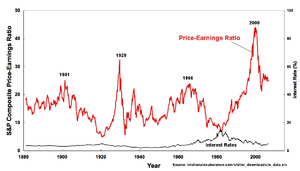Most people when investing simply have this nebulous idea of "make money". But the "goal" is more than that. The goal affects the style, and you can't have an investment strategy without considering all of the above.
First, let us define the goal.
What is your investment goal? It is a monetary figure, but it also depends on your risk level AND your reward level. Risk is linked to reward, there's no way around it. The risks varies from US Treasury Bonds (guaranteed return, virtually risk free) to super-volatile tech and such stocks (extreme risk). So, what are your goals?
Specify your expected annual return, and be reasonable. In this economy (circa Oct 2009), 15% may be pushing it. 20-30% is unreasonable. Keep in mind, the higher the return you want, the higher the risk. The risk then defines how much of your portfolio should be allocated to it. Steady smaller growth, like 10% a year (revised later) is certainly achievable.
You can also help figure out your goal by the time-frame, such as target portfolio size, and work backwards to annual rate of return based on your current portfolio size. Is this for retirement? College fund? Vacation? Other? The time-frame available and the amount you need would tell you your goal.
Second, you can now define the "style" as you now know the goal, as the style must "fit" the goal. If you are going conservative, then you wouldn't really be doing "day-trading". Styles vary from extreme day trading (squeezing margin of .25 to .50 points) to super-long-term using macro-economic model (taking 2-5 year positions), and anything in between.
Different styles uses different time frames of information, and requires different commitment level from the investor. A long-term value investor is in a buy-it-and-forget-it mood, while day-traders who trade on intra-day patterns are committed every minute/hour of trading day.
Some possible styles:
Day traders: average time-frame is 15 minutes to 1 day, extreme commitment
Swing trader: average time-frame of 1 to 5 days, high commitment
Position traders: average time-frame of 1 to 8 weeks, medium commitment
Value traders: average time-frame of 1 to 2 years, low commitment
Long-term traders: average time-frame of 2-10 years, very low commitment
You may also want to define stop-loss strategy here, as well as max trade limit (i.e. how much of the capital would you commit with one trade, out of your portfolio)
Finally, once you picked your style, you can then settle on the strategy you want to use to fit your goal and style. Basically, it means picking which indicators and its variants to use and sticking to it. If you are doing value investing, what criteria would you be using. Remember, you should be using several different indicators to confirm the buy and sell signals. If you want to use combination of approaches, write them all down in steps, which confirms what, what constitutes a "buy" signal in your strategy, and what constitutes a sell. Define your stop-loss strategies, and exit points.
Let's say you picked style of "positional traders".
A hypothetical strategy would be
1) By employing EMAs of of 30 and 100 (i.e. PPO of 30,100,1), stochastic of 39, advance/decline line, and divergence, I hope to confirm trend changes
2) By employing patterns such as head-and-shoulders, flag, and gap, combined with buy-signals from above indicators, I will initiate buys, and similarly for sells.
3) I will follow stop-loss criteria I set in the "style" section, and lock in some profits by selling 50% of my portfolio when gains reach 10% for one stock.
4) I will look for companies that have been growing for past 5 years at over 10% annually, and debt to equity ratio of no more than 25%.
etc.
It may be prudent to create three separate portfolios, each with different goals, styles, and thus, strategies: 60% low-risk, 30% medium risk, and 10% high risk, or whatever "pyramid" you choose to deploy, as long as it's small high-risk, medium medium-risk, and large low-risk.


![Reblog this post [with Zemanta]](http://img.zemanta.com/reblog_e.png?x-id=60a97373-4f07-4fba-8a7c-758ac9590f99)